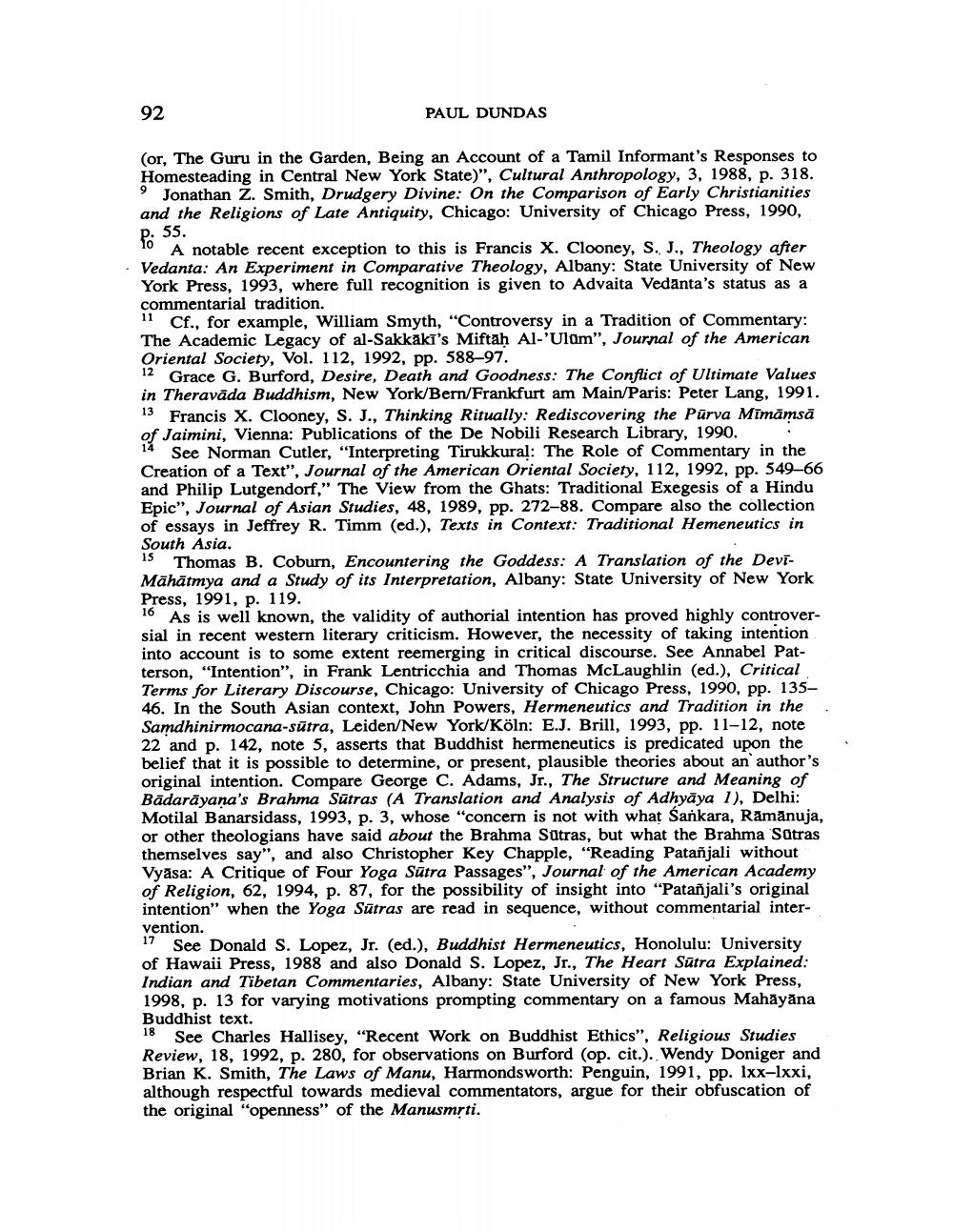________________
92
PAUL DUNDAS
(or, The Guru in the Garden, Being an Account of a Tamil Informant's Responses to Homesteading in Central New York State)", Cultural Anthropology, 3, 1988, p. 318. 9 Jonathan Z. Smith, Drudgery Divine: On the Comparison of Early Christianities and the Religions of Late Antiquity, Chicago: University of Chicago Press, 1990,
P: 55.
10 A notable recent exception to this is Francis X. Clooney, S., J., Theology after • Vedanta: An Experiment in Comparative Theology, Albany: State University of New
York Press, 1993, where full recognition is given to Advaita Vedanta's status as a commentarial tradition. 11 Cf., for example, William Smyth, “Controversy in a Tradition of Commentary: The Academic Legacy of al-Sakkaki's Miftah Al-'Ulam", Journal of the American Oriental Society, Vol. 112, 1992, pp. 588-97. 12 Grace G. Burford, Desire, Death and Goodness: The Conflict of Ultimate Values in Theravada Buddhism, New York/Bern/Frankfurt am Main/Paris: Peter Lang, 1991. 13 Francis X. Clooney, S. J., Thinking Ritually: Rediscovering the Purva Mīmāmsā of Jaimini, Vienna: Publications of the De Nobili Research Library, 1990. 14 See Norman Cutler, “Interpreting Tirukkural: The Role of Commentary in the Creation of a Text", Journal of the American Oriental Society, 112, 1992, pp. 549-66 and Philip Lutgendorf," The View from the Ghats: Traditional Exegesis of a Hindu Epic", Journal of Asian Studies, 48, 1989, pp. 272–88. Compare also the collection of essays in Jeffrey R. Timm (ed.), Texts in Context: Traditional Hemeneutics in South Asia. 15 Thomas B. Coburn, Encountering the Goddess: A Translation of the DeviMāhātmya and a Study of its Interpretation, Albany: State University of New York Press, 1991, p. 119. 16 As is well known, the validity of authorial intention has proved highly controversial in recent western literary criticism. However, the necessity of taking intention into account is to some extent reemerging in critical discourse. See Annabel Patterson, "Intention", in Frank Lentricchia and Thomas McLaughlin (ed.), Critical Terms for Literary Discourse, Chicago: University of Chicago Press, 1990, pp. 13546. In the South Asian context, John Powers, Hermeneutics and Tradition in the Samdhinirmocana-sūtra, Leiden/New York/Köln: E.J. Brill, 1993, pp. 11-12, note 22 and p. 142, note 5, asserts that Buddhist hermeneutics is predicated upon the belief that it is possible to determine, or present, plausible theories about an author's original intention. Compare George C. Adams, Jr., The Structure and Meaning of Bādarāyana's Brahma Sūtras (A Translation and Analysis of Adhyāya 1), Delhi: Motilal Banarsidass, 1993, p. 3, whose "concern is not with what Sankara, Ramanuja, or other theologians have said about the Brahma Sutras, but what the Brahma Sätras themselves say", and also Christopher Key Chapple, "Reading Patanjali without Vyāsa: A Critique of Four Yoga Sūtra Passages", Journal of the American Academy of Religion, 62, 1994, p. 87, for the possibility of insight into "Patañjali's original intention" when the Yoga Sūtras are read in sequence, without commentarial inter
vention.
17 See Donald S. Lopez, Jr. (ed.), Buddhist Hermeneutics, Honolulu: University of Hawaii Press, 1988 and also Donald S. Lopez, Jr., The Heart Sutra Explained: Indian and Tibetan Commentaries, Albany: State University of New York Press, 1998, p. 13 for varying motivations prompting commentary on a famous Mahāyāna Buddhist text. 18 See Charles Hallisey, "Recent Work on Buddhist Ethics", Religious Studies Review, 18, 1992, p. 280, for observations on Burford (op. cit.). Wendy Doniger and Brian K. Smith, The Laws of Manu, Harmondsworth: Penguin, 1991, pp. lxx-lxxi, although respectful towards medieval commentators, argue for their obfuscation of the original "openness" of the Manusmrti.




